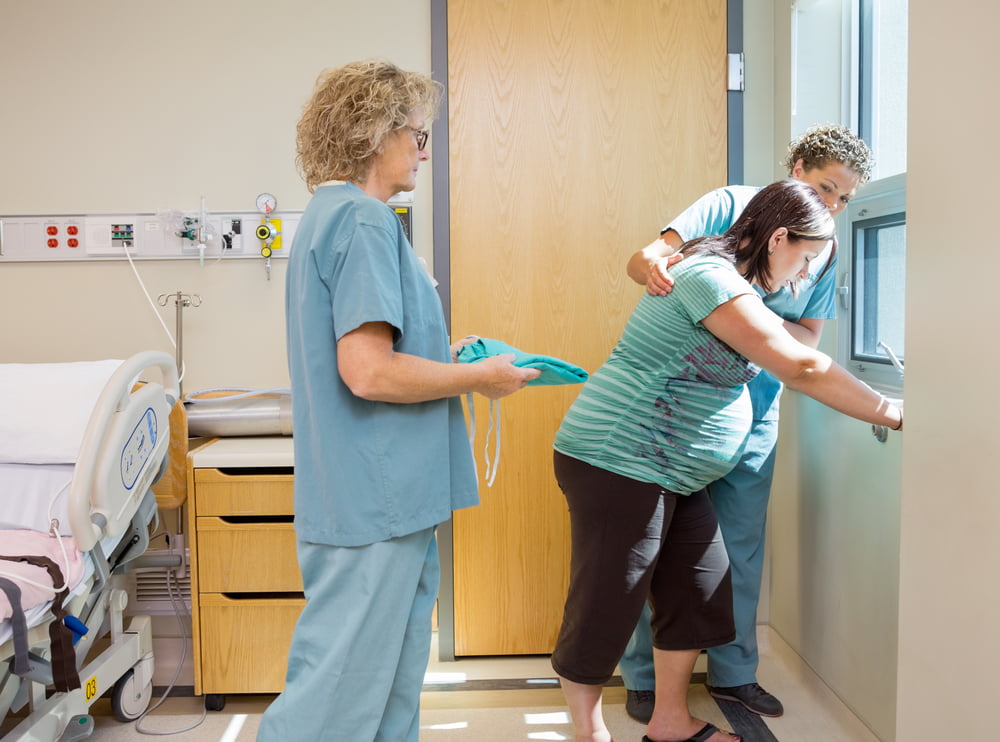
Editor’s note 24 August 2022: The Cochrane ReviewCochrane Reviews are systematic reviews. In systematic reviews we search for and summarize studies that answer a specific research question (e.g. is paracetamol effective and safe for treating back pain?). The studies are identified, assessed, and summarized by using a systematic and predefined approach. They inform recommendations for healthcare and research. has since been updated and you can read this blog about it: Implementing midwife-led continuity models of care and what do we still need to find out?
The best way to organise maternity care, in terms of clinical and cost effectivenessThe ability of an intervention (for example a drug, surgery, or exercise) to produce a desired effect, such as reduce symptoms., continues to be subject to debate.
Here in the UK, combinations of midwife-led, medical-led and shared models of care are available. Midwife-led continuity models of care vary but the defining feature is that a midwife, working with the woman, takes the lead in planning, organising and delivering her care from her first antenatal booking to the postnatal period. Sometimes a team of midwives shares a caseload. Midwife-led care in this review included care delivered in the hospital setting. A Cochrane review has found reliable evidence that there are benefits of midwife-led care compared with alternative approaches, for example where the lead professional is a doctor, or changes at different points.
The review
The Cochrane review includes 15 randomizedRandomization is the process of randomly dividing into groups the people taking part in a trial. One group (the intervention group) will be given the intervention being tested (for example a drug, surgery, or exercise) and compared with a group which does not receive the intervention (the control group). controlled trialsA trial in which a group (the ‘intervention group’) is given a intervention being tested (for example a drug, surgery, or exercise) is compared with a group which does not receive the intervention (the ‘control group’). from the UK, Ireland, Canada and Australia, with 17,674 women with low- or mixed- riskA way of expressing the chance of an event taking place, expressed as the number of events divided by the total number of observations or people. It can be stated as ‘the chance of falling were one in four’ (1/4 = 25%). This measure is good no matter the incidence of events i.e. common or infrequent. pregnancies. All midwives involved were licensed. Home birth was not offered in any of the trialsClinical trials are research studies involving people who use healthcare services. They often compare a new or different treatment with the best treatment currently available. This is to test whether the new or different treatment is safe, effective and any better than what is currently used. No matter how promising a new treatment may appear during tests in a laboratory, it must go through clinical trials before its benefits and risks can really be known..
What they found

Midwife-led care was associated with a number of important benefits for mothers and babies and had no more adverse effects than other models of care.
Women who had midwife-led care were less likely to experience regional analgesia, instrumental vaginal birth, preterm birth less than 37 weeks and fetal loss before 24 weeks gestation. They were more likely to have a longer labour, spontaneous vaginal birth and be attended at birth by a known midwife. There was no difference between the groups for a number of other outcomesOutcomes are measures of health (for example quality of life, pain, blood sugar levels) that can be used to assess the effectiveness and safety of a treatment or other intervention (for example a drug, surgery, or exercise). In research, the outcomes considered most important are ‘primary outcomes’ and those considered less important are ‘secondary outcomes’. including caesarean birth or intact perineum.
The review also provides some insight into women’s satisfaction with care and the costs of different models of care, although differences in the way these were measured meant that the results had to be described, rather than combined in a meta- analysis. Most studies reported greater satisfaction with various aspects of care in midwife-led continuity-led care compared with other models, and it appears to be cheaper than medical-led care.
Quality of the evidence
The evidence for all the primary outcomes was graded as high quality, which means we can be confident about the findings.
What we don’t know
This review provides reliable evidence that midwife- led models of care offer specific benefits for mothers and babies. What we don’t know is why. The influence of the model and philosophy of care, and the nature of the relationship between the midwives and mothers, are all potentially important and should be explored in future research. The reviewers highlight other areas that are important to investigate, including: newer midwife-led continuity models of care, such as those that include home birth; the reasons for fewer fetal deaths and preterm births with midwife-led care; and the effects of care models on mothers’ and babies’ health in the longer postpartum period.
Reflections on the review, by Alys Einion

The review by Sandall et al (2015) set out to evaluate and compare the outcomes of models of care defined as being ‘midwife led continuity’ models, which incorporate caseloading. This is a highly topical issue which links to many aspects of the role of the midwife.
The authors of the review define terms in detail that are important in understanding the specific benefits of the defined approaches to care. This includes continuity of care, which involves care by the same team or individual over the period of the pregnancy and puerperium, but Sandall et al (2015) also acknowledge poor definitions of continuity. This is understandable, given that midwife-led care is person-centred and individualised, rather than standardised. This highlights one of the key issues in finding and evaluating evidence about midwifery care from randomised controlled trials.
Reference is made to the benefits of midwifery- led and continuity based models of care for childbearing women. Sandall et al (2015) set out to compare outcomes from midwifery-led models of care which are continuity based, and to see how much these outcomes are influenced by differences in continuity and relationships, and differences in the risk status of the pregnant women being studied. Relational issues are of prime importance to women experiencing maternity care (Clark et al 2015). Risk is a particularly topical issue within maternity care (Healey et al 2015).
Methods
The authors carried out a comprehensive search of the Cochrane Pregnancy and Childbirth specialised register, which is regularly updated, and correlated the findings to summarise the evidence presented by the included trials.
Implications for practice

The findings of this review show no increase in the likelihood of any adverse effects from the provision of midwifery-led continuity models of care.
The review indicates that midwifery-led models lead to less use of interventions, which has many implications for women’s experiences, autonomy and satisfaction.
Other important outcomes support midwife-led models of care, including a reduced likelihood of experiencing pre-24 weeks fetal loss, and preterm birth. This is something of significant concern to mothers and to care providers (Moon 2015). Sandall et al (2015) importantly state that the reduction in preterm birth in this review is 24 per cent; a significant finding.This is a strong argument, perhaps one of the strongest, for the value of these models of care, and can be used to influence policy making within clinical practice.
The reduced use of interventions also has implications for costs and resource issues, which is of importance in the current climate of resource scarcity. This can be used to endorse the argument that resources should be focused on midwife-led and continuity models of care.
The review clearly shows no increased risk associated with midwife-led continuity models of care within clinical settings, although it did not cover home birth, only in- hospital and birth centre birth. This provides positive support for midwives advocating to women for birth centre birth and also advocating for continuity of carer during pregnancy, labour and birth.
The authors admit that the complexity of care requires much more investigation to understand more detailed dimensions of this mode of care and the nature of the relationship between the woman and the midwife. However, the findings suggest benefits to this approach to care which should provide midwives with the evidence to lobby governments and healthcare providers for changes in approaches to care, and to continue to promote midwifery models of care and re-vision the future of maternity service design and commissioning.

Midwife-led continuity models versus other models of care by Sarah Chapman and Alys Einion is licensed under a Creative Commons Attribution-NoDerivatives 4.0 International License.
Based on a work at http://onlinelibrary.wiley.com/doi/10.1002/14651858.CD004667.pub4/abstract.
Permissions beyond the scope of this license may be available at http://www.practisingmidwife.co.uk/page.php?id=1.
Images have been purchased from istock.com and shutterstock.com for Evidently Cochrane and are not available for reproduction.
Links:
Chapman S. Cochrane Corner: Midwife-led continuity models versus other models of care for childbearing women, Sandall et al (2015).Practising Midwife 2016;19(3):34. Available from: www.practisingmidwife.co.uk
Einion A. Cochrane Corner: Reflections on the review. Practising Midwife 2016;19(3):35. Available from: www.practisingmidwife.co.uk
Sandall J, Soltani H, Gates S, Shennan A, Devane D. Midwife‐led continuity models versus other models of care for childbearing women. Cochrane Database of Systematic ReviewsIn systematic reviews we search for and summarize studies that answer a specific research question (e.g. is paracetamol effective and safe for treating back pain?). The studies are identified, assessed, and summarized by using a systematic and predefined approach. They inform recommendations for healthcare and research. 2016, Issue 4. Art. No.: CD004667. DOI: 10.1002/14651858.CD004667.pub5. https://www.cochranelibrary.com/cdsr/doi/10.1002/14651858.CD004667.pub5/full
Clark K, Beatty S and Reibel T (2015). ‘Maternity care: a narrative overview of what women expect across their care continuum’. Midwifery, 31(4): 432–437.
Healey S, Humphreys E and Kennedy C (2015). ‘Midwives’ and obstetricians’ perceptions of risk and its impact on clinical practice and decision-making in labour: an integrative review’. Women and Birth, in press. http://tinyurl.com/jdlcq4m
Moon EJ (2015). A comparison of maternity care models and their relationship to adverse fetal and neonatal outcomes: a retrospective cohort studyAn investigation of a healthcare problem. There are different types of studies used to answer research questions, for example randomised controlled trials or observational studies. based in New Zealand (Thesis, Master of Public Health), Dunedin: University of Otago. http:// tinyurl.com/h665hnb



NZ only has few numbers of women who opt for Dr led care which is supposed to be the same continuity model (LMC) and yes they do have higher levels of intervention. But 84% of all NZ women most of whom (97%) have midwives as LMC, labour and birth in maternity hospitals and so intervention rates overall have been increasing since this model became universally available! So NZ shows that Place of birth is as important or more important that continuity of carer.